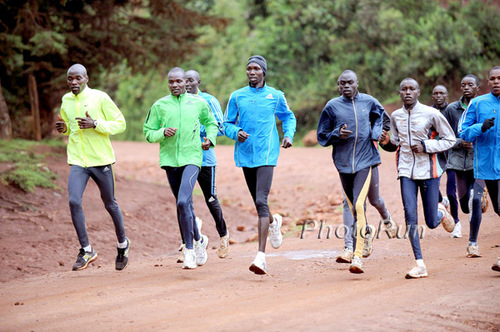Justin Lagat is our correspondent from Eldoret, Kenya. Through his writing, we get a view of the world in Kenya. In this column, Justin explains why we see new athletes surprising us on the global road scene and track scene.
RelatedPosts
LONG DISTANCE DARK HORSES
Do you believe that a hardly known athlete can possibly come out from nowhere and break a world record in a long distance running event? Well, you have the right not to agree with me, but I do, and I have some arguments to persuade you to believe it also.
Dennis Kipruto, who wasn’t known until he defeated Wilson Kiprop to win the Berlin half marathon in April this year, just did something close to that. He broke the 25km world record less than two months after getting noticed, setting a new world record of 1:11:18. There are no progressive records of his runs before July last year.
But, do not think that he just started running last year. Many Kenyan long distance runners spend over seven years training and running before they can find any proof of their running to help them secure agents and get to be entered in races with faster courses abroad.
Nathaniel Kipkosgei is one great example of this. I met him at the finish line during the Nairobi Marathon event in 2010 where he had run the 10km, and I had done the 21km event. He told me he was seeking an agent and gave me his contacts so that I could keep in touch with him just in case I got lucky on my side to get one.
We had earlier been training together at Mosoriot (near Eldoret) before he moved to Ngong, Nairobi. I contacted a few agents that year, and none was interested in him, or in me. He however got a rare opportunity to go and pace the Eindhoven marathon last year and ended up finishing it instead, in a time of 2:06:28!
In 2006, in Brussels, Micah Kogo of Kenya amazed the world by running a time of 26:35 in the 10,000m event, the sixth fastest time ever in history at that time, despite not having any impressive records prior to that. “Who is Micah Kogo?” was one of the phrases that probably got the highest number of hits on the internet that year.
This is what happens in most races in Kenya and why most strong Kenyan athletes do not get noticed for a very long time: A large number of seasoned athletes turn up for an event, seizing the only rare chance for them to be spotted by an agent who will in turn give them the opportunity to go and run in races abroad and better their lives, but just a few get to realize their dreams.
The rest don’t even get any proof of participation because no one is there to record their times at the finish lines, they only check it on their wrist watches and head back home hoping that they will get to the top ten positions the following year.
“I cannot compare any race abroad with the ones here in Kenya. Kenyan races are very competitive and anyone who can manage a top 50 position is capable of winning any race abroad,” said Mutai, the world’s fastest marathoner, last month when I was talking with him. There is always so much jostling at the starting, and nothing can be done about that because everyone needs a level playing ground, unlike in other countries where runners are arranged according to their projected finishing times. Here, everyone expects to win. And indeed, new faces always emerge to win most of the Kenyan races; Geoffrey Mutai was defeated to a third position by new faces in this year’s Sotokoto half Marathon in July. Victor Kipchirchir won, followed by Peter Some.
Many strong athletes here in Kenya have never gotten a chance to harvest from their talents because of the following reasons: Firstly, except for the Nairobi Marathon, no other race has made a considerable effort to time athletes on the finish line and this is vital for them in getting invitations to race abroad. Secondly, most athletes are too poor to sponsor themselves to go out and run in races that can help them post their times. And thirdly, there are relatively few races in Kenya.
So, next time you see any Kenyan, or an Ethiopian to some extent, who has no past impressive records at the starting line of a long distance race, don’t make any judgments against him, he could be another dark horse.
Author

Larry Eder has had a 52-year involvement in the sport of athletics. Larry has experienced the sport as an athlete, coach, magazine publisher, and now, journalist and blogger. His first article, on Don Bowden, America's first sub-4 minute miler, was published in RW in 1983. Larry has published several magazines on athletics, from American Athletics to the U.S. version of Spikes magazine. He currently manages the content and marketing development of the RunningNetwork, The Shoe Addicts, and RunBlogRun. Of RunBlogRun, his daily pilgrimage with the sport, Larry says: "I have to admit, I love traveling to far away meets, writing about the sport I love, and the athletes I respect, for my readers at runblogrun.com, the most of anything I have ever done, except, maybe running itself." Also does some updates for BBC Sports at key events, which he truly enjoys. Theme song: Greg Allman, " I'm no Angel."
View all posts





















